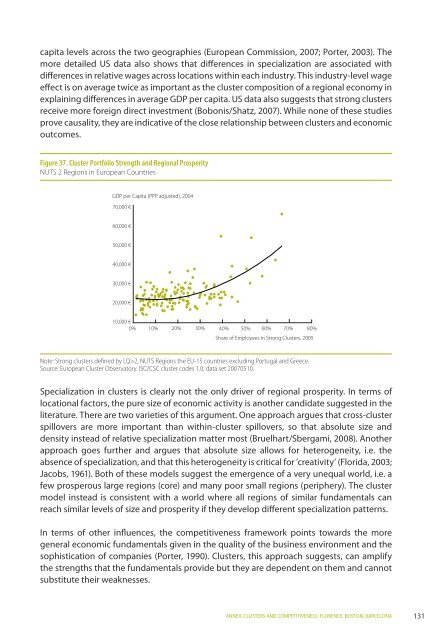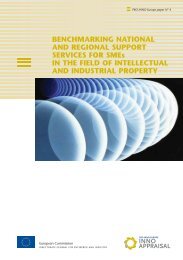Clusters and competitiveness - PRO INNO Europe
Clusters and competitiveness - PRO INNO Europe
Clusters and competitiveness - PRO INNO Europe
Create successful ePaper yourself
Turn your PDF publications into a flip-book with our unique Google optimized e-Paper software.
capita levelsacrossthetwogeographies(<strong>Europe</strong>anCommission,2007;Porter,2003).The<br />
moredetailedUSdataalsoshowsthatdifferencesinspecializationareassociatedwith<br />
differences in relative wages across locations within each industry. This industry-level wage<br />
effectisonaveragetwiceasimportantastheclustercompositionofaregionaleconomyin<br />
explainingdifferencesinaverageGDPpercapita.USdataalsosuggeststhatstrongclusters<br />
receivemoreforeigndirectinvestment (Bobonis/Shatz, 2007). While none of these studies<br />
provecausality,theyareindicativeofthecloserelationshipbetweenclusters<strong>and</strong>economic<br />
outcomes.<br />
Figure 37. Cluster Portfolio Strength <strong>and</strong> Regional Prosperity<br />
NUTS 2 Regions in <strong>Europe</strong>an Countries<br />
GDP per Capita (PPP adjusted), 2004<br />
70,000 €<br />
60,000 €<br />
50,000 €<br />
40,000 €<br />
30,000 €<br />
20,000 €<br />
10,000 €<br />
0%<br />
10% 20% 30% 40% 50% 60% 70% 80%<br />
Share of Employees in Strong <strong>Clusters</strong>, 2005<br />
Note: Strong clusters defined by LQ>2, NUTS Regions the EU-15 countries excluding Portugal <strong>and</strong> Greece.<br />
Source: <strong>Europe</strong>an Cluster Observatory. ISC/CSC cluster codes 1.0, data set 20070510.<br />
Specialization inclustersisclearlynottheonlydriverofregionalprosperity.Intermsof<br />
locational factors, the pure size of economic activity is another c<strong>and</strong>idate suggested in the<br />
literature. There are two varieties of this argument. One approach argues that cross-cluster<br />
spillovers aremoreimportantthanwithin-clusterspillovers,sothatabsolutesize<strong>and</strong><br />
density instead of relative specialization matter most (Bruelhart/Sbergami, 2008). Another<br />
approach goesfurther<strong>and</strong>arguesthatabsolutesizeallowsforheterogeneity,i.e.the<br />
absence of specialization, <strong>and</strong> that this heterogeneity is critical for ’creativity’ (Florida, 2003;<br />
Jacobs,1961).Bothofthesemodelssuggesttheemergenceofaveryunequalworld,i.e.a<br />
fewprosperouslargeregions(core)<strong>and</strong>manypoorsmallregions(periphery).Thecluster<br />
modelinsteadisconsistentwithaworldwhereallregionsofsimilarfundamentalscan<br />
reach similar levels of size <strong>and</strong> prosperity if they develop different specialization patterns.<br />
In terms of other influences, the <strong>competitiveness</strong> framework points towards the more<br />
general economic fundamentals given in the quality of the business environment <strong>and</strong> the<br />
sophistication ofcompanies(Porter,1990).<strong>Clusters</strong>,thisapproachsuggests,canamplify<br />
the strengths that the fundamentals provide but they are dependent on them <strong>and</strong> cannot<br />
substitute their weaknesses.<br />
ANNEX: CLUSTERS AND COMPETITIVENESS: FLORENCE, BOSTON, BARCELONA<br />
131
















